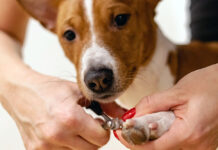What is Hip Dysplasia?
The hip joint consists of a “ball” on the femoral bone, and a “socket” on the hip bone.
Canine hip dysplasia simply defined is when a dog’s hips do not develop normally and the ball does not fit snugly into the socket.
What Causes Hip Dysplasia?
While there is no “conclusive proof” of the cause of hip dysplasia, there are 2 general schools of thought about its cause – 1) genetic or 2) environmental
These two differing viewpoints often place the dog breeders at odds with the dog owners, causing each to blame the other for the problem.
Genetic: The puppy is born with the problem
Environmental: The puppy is too heavy resulting in excessive growth and/or over or under exercising a puppy during its growth phase resulting in developmental problems.
The most common theory is that hip dysplasia is indeed genetic. Most breeders have their breeding dogs’ hips rated by the Orthopedic Foundation for Animals (OFA) or Pennsylvania Hip Improvement Program (Penn-HIP), or various other international orthopedic groups.
We could discuss the merits of both theories, but it doesn’t change the facts. If your dog has hip dysplasia, you need to deal with it. You may be deciding what to do next, or you may have already decided, and want to know what to expect.
When Does a Dog Get Hip Dysplasia?
If you subscribe to the theory that it is genetic, they are born with it. Dogs that have severe hip dysplasia often begin to have problems as puppies. Sometimes, the hip dysplasia does not cause pain for the dog, so they do not show signs of it until they develop arthritis in their hip joints. Some dogs that are not as severe can live out their entire lives with few, if any symptoms.
What are the Symptoms of Hip Dysplasia?
There are a number of symptoms of hip dysplasia. Some dog owners only say that their dog didn’t walk right. Others will say they saw no symptoms at all, or just that their dog began to limp. Following is a list of common symptoms, of which your dog may have a couple and not have hip dysplasia.
Bunny Hopping: The dog tends to use both hind legs together, rather than one at a time. This occurs when the dog is running, or going up stairs.
Side Sit: Also called lazy sit, slouch or frog sit. When the dog sits, its legs are not positioned bent and close to the body. They can be loose and off to one side, or one or both legs may be straight out in front.
Sway Walk: Also called a loose walk. When the dog is walking, the back end sways back and forth because the hips are loose.
Unusual Laying Position: Legs are straight out and off to the side when the dog is laying on its stomach or legs are straight out behind the dog. (All dogs lay with their legs behind them on occasion, many dogs with hip dysplasia lay like this all the time.)
Limping: The dog may favor one hind leg or the other, and may alternate legs that it is favoring.
Quiet Puppy: Puppies who are already in pain from hip dysplasia tend to be very good puppies. They do not rough house the way that normal puppies do. They also tend to sleep for a long time after playing or going for a walk. Some owners describe their puppy with hip dysplasia as the best puppy they’ve ever had.
Dog Doesn’t Jump: Not only do they not jump on you, they seem to pull themselves up by their front end onto furniture as opposed to jumping up.
Underdeveloped Hind Quarters and Overdeveloped Chest: This is caused by the failure to use the hind legs normally and jump. The dog also may actually be shifting weight forward.
Diagnosing Hip Dysplasia
The only way to diagnose hip dysplasia is with x-rays. However, I must note here that you should treat the dog and not the x-rays. Some dogs with seemingly mild hip dysplasia are in a lot of pain, while other dogs with apparent severe hip dysplasia do not display symptoms.
What Can Be Done for My Dog?
If you have had x-rays taken of your dog’s hips at your regular vet, you may have been referred to an orthopedic surgeon. The surgeon is going to recommend various surgical options for your dog. I am going to give you a very brief overview of these surgeries. You will need to discuss your dog’s options with the surgeon. They will provide the details of each surgical option. Some people are able to treat their dog with nutritional supplements and avoid surgery. Ultimately, it will be your decision to determine the best treatment for your dog.
Surgical Options:
Juvenile Pubic Symphysiodesis (JPS) – This surgery is performed on puppies under 20 weeks of age, generally when the puppy is neutered or spayed. It shows great promise as a preventive measure, by altering the pelvic growth. This surgery has a short recovery period, but is generally done before a puppy can be diagnosed. However, once you’ve lived with hip dysplasia, it may prove to be worthwhile for a puppy considered at risk for developing hip dysplasia.
Dorsal Acetabular Rim (DAR) – This surgery consists of bone grafts being taken from other areas of the pelvis to build up the rim on the hip socket (cup). The idea is for the femoral head to have a deeper socket to fit into. It’s relatively new, so there is some question as to how a dog will do into old age – there aren’t many older dogs that have had it done.
Triple Pelvic Osteotomy (TPO) – This surgery involves cutting the bone around the hip socket and repositioning the socket for a better fit with the femoral head. The bones are plated back together so they heal in the correct alignment. This surgery is performed on young dogs before they have finished growing.
Total Hip Replacement (THR) – This surgery consists of replacing the hip joint similar to a human hip replacement. A new cup is usually attached to the hip bone, and the femoral head is cut off the leg bone and an implant is inserted into the leg bone. This surgery is done on more mature dogs that have finished growing. Due to the size of the implants, this surgery is done on larger dogs. Previously, all artificial hip components were cemented in place. More recently, cementless hip replacements are being performed.
Femoral Head & Neck Ostectomy (FHO) – This surgery consists of removing the femoral head of the leg bone to eliminate the pain of hip dysplasia. The dog’s body will then develop scar tissue to create an artificial hip joint. Long considered only appropriate for smaller dogs or as a salvage operation for a failed THR, it has become increasingly popular for larger dogs.
Non-Surgical or Conservative Management Option
Many people choose to have surgery performed on their dog only as a last resort. Some are able to manage their dog’s hip dysplasia with supplements, acupuncture, chiropractic care, exercise and weight management. Sometimes, the puppy will show signs of pain from hip dysplasia, and once it is done growing and the muscles are fully developed, they seem to “go into remission”, developing signs of hip problems again as the dog ages. Surgical options are still available to you if the conservative path is unsuccessful.
For additional information on hip dysplasia, please visit
The American Kennel Club




















